Alexa Im Having Trouble Understanding Right Now Please Try Again Later
Uh oh!
Then, you but bought your new fish and are just just now learning almost this cycling affair…
Or, perhaps yous are post-obit the terrible advice of the pet store employee who said you lot merely need to run your filter for 24 hours before adding your fish.
Perchance information technology's even worse. You killed all the adept bacteria in your tank and accept to cycle your aquarium all over over again.
Don't worry! These scenarios are much more than mutual than yous recollect.
If y'all tin can't return your fish, so y'all have only i pick:
Yous have to cycle your aquarium the old-fashioned manner – with fish in the tank.
Today, I am going to show y'all how to successfully bicycle your aquarium with fish inside.
If yous oasis't bought your fish but even so, I recommend using the fishless wheel, which is an easier, faster and safer fashion to cycle your aquarium. Interested? FishLab's fishless cycling guide will walk you through the procedure.
What is fish-in cycling?
The purpose of a fish-in cycle is to kick-start the nitrogen wheel, an invisible three-phase process where benign (practiced) bacteria plant themselves in your filter, keeping your fish safe from ammonia.
I embrace the nitrogen cycle in much greater detail here. If y'all are new to the hobby, it'southward worth reading because an effective nitrogen cycle is mayhap ane of the most of import parts of a healthy tank.
For the residue of yous, here's a quick recap of the nitrogen bike in action…
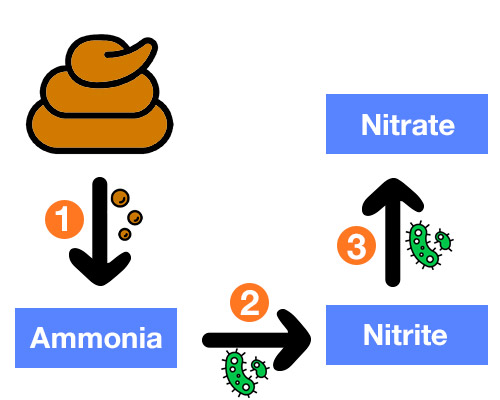
Phase 1 Waste such as pee, poop and uneaten fish nutrient suspension down, releasing ammonia, a toxic chemic, into the water.
Stage ii Beneficial bacteria eat the ammonia and release nitrites, yet another toxic chemical.
Stage 3 A second blazon of benign bacteria eat the nitrites and convert them to nitrates, which are harmless in minor amounts and are removed from your aquarium each time you perform a water change.
Important: With simply a single alphabetic character separating nitrites and nitrates, it's easy to confuse the ii. Remember… Nitrites are highly toxic to your fish while nitrates are not harmful in small-scale amounts.
Merely one trouble…
At that place aren't any beneficial bacteria in a brand new aquarium. And without it, toxic ammonia and nitrites build upwardly, causing serious harm to your fish…
So, it'south up to y'all to kick-start the nitrogen wheel. And to do that, you need some help from your fish, well from their pee and poop.
As the poop breaks down, it releases ammonia and encourages the beneficial bacteria to announced.
You might have noticed a flaw in this…
If ammonia is harmful to fish, and you are using your fish equally a source of ammonia, doesn't this harm them?
Well, that'southward exactly what brings me to my side by side bespeak…
Why shouldn't yous use a fish-in cycle?
In an emergency, a fish-in wheel might be your only selection. If that's the instance, cycling with fish is perfectly acceptable because your fish might die if yous don't.
Simply if you have a pick, then you shouldn't be cycling your aquarium with fish inside.
Why?
Well, a picture says information technology best…
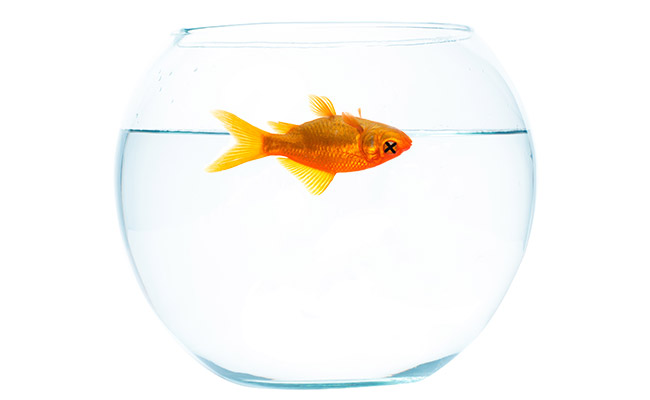
Yep, fish-in cycling is very stressful for your fish. And, many fish won't survive the procedure. Those that practice are frequently more susceptible to affliction and live shorter lives.
I assume you lot want to go along your pet fish alive every bit long as possible, correct? Well, a fish-in cycle is a terrible way to start.
And so, why is a fish-in cycle so harmful to fish?
Well, during the cycling process you are waiting for beneficial bacteria to establish a colony in your aquarium. And once they do, they will exist able to consume ammonia and nitrites as quickly every bit they are produced.
Just one problem…
While you are waiting for the bacteria to grow in numbers, your fish are going to be exposed to elevated levels of ammonia and nitrites. Even at low levels, these toxic substances tin stress and severely irritate your fish.
Not merely that, but a fish-in cycle requires delicate planning and leaves picayune room for error. It'due south not exactly beginner-friendly.
Now… I'm not trying to say that fish-in cycling doesn't work. It certainly can. But considering the obvious harm that information technology tin cause your fish, it should simply be washed in an emergency.
To be honest, given that you tin at present cycle your aquarium without fish, it's puzzling to run across the dated fish-in bike still being recommended.
So, why do people continue to give the advice that information technology's okay to bicycle your aquarium with fish in it?
I was chatting with my local, big-box pet shop the other twenty-four hour period, and the employee was preaching the wonders of fish-in cycling. I would also like to indicate out that he was trying to convince me to buy fish to become with my new aquarium.
The reason was pretty clear… An actress auction. A pretty scummy motion, right?
But in other cases, the advice to cycle with fish is much less sinister.
You see, fish-in cycling is how your grandparents would have cycled their tank. Yep, this method has been in use for that long. In fact, this was the only way to bicycle a tank back and so.
In these instances, the advice to become with a fish-in cycle came from the best of intentions, people passed on what they learned years ago. You tin't error them for that. But you can error them for not keeping up with the times! Fortunately, yous now know better!
Look, I'm certain some of you are going to disagree with me on this. Possibly you have successfully used a fish-in cycle hundreds of times without harm. That's cool too…
But for a beginner, a fishless cycle is by far the best way to go. And in this example, a fish-in cycle should only be used when absolutely necessary.
The hole-and-corner to successfully cycling with fish in your tank
I'k going to let you in on a niggling underground…
You can tell whether your fish-in cycle is going to be a success or failure before y'all even begin.
Seriously.
And, information technology all comes down to the number of fish you have in your aquarium.
More fish = more poop and pee
Since this waste material breaks down into ammonia, your ammonia levels are going to rise rapidly.
And the faster your ammonia levels ascent, the more harm done to your fish.
So, what is the correct number of fish to use in a fish-in cycle?
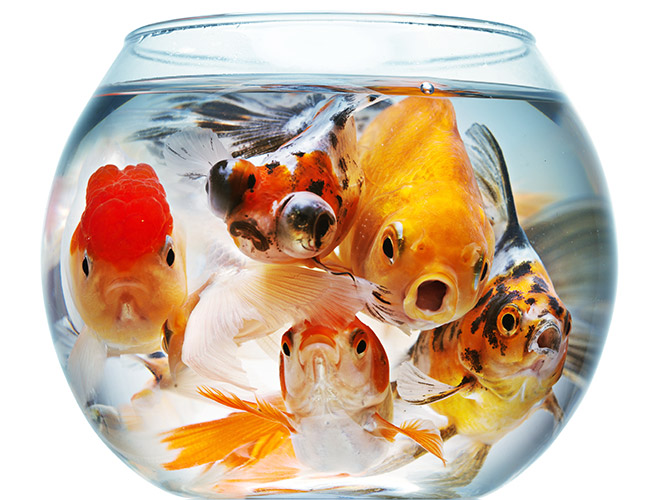
Plain, this aquarium is too small for the number of fish…
The larger your aquarium, the more fish you can include in a fish-in cycle.
Dominion of thumb: One fish for every ten gallons of water.
Then, if your tank is 1 gallon, only 1 fish. If your tank is 58 gallons, 5 fish.
Don't know your tank size? Use FishLab's gallon figurer.
Merely what if you have more fish than should exist in your tank?
Ideally, you want to do 1 of the following:
1. Give your fish away – Either return your fish, requite them to a friend or contact your local fish social club to see if anyone will take them.
2. Buy a larger tank – Buying a larger tank will increase the corporeality of fish you tin can cycle with.
Just what if neither of these is an option?
Well, unfortunately it's time for you lot to make a judgment call.
Practise you try and bike your aquarium with all your fish inside and risk killing them all?
Or, exercise you lot euthanize some, giving the residuum a much greater gamble of survival?
Information technology'due south a tough determination that merely you tin can make.
Decided to euthanize? Delight read FishLab'southward guide to humanely killing fish. If y'all have to do it, delight do it correctly.
Essential products to perform a fish-in cycle
In addition to your fish, tank and equipment like filters and heaters, y'all need 2 very important products to ensure that your tank is cycled correctly…
i. An aquarium test kit
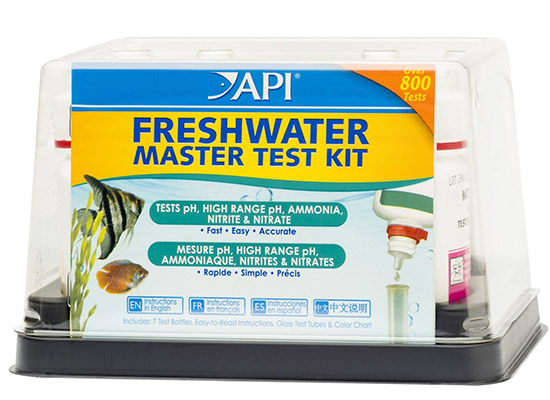
The trouble with the nitrogen cycle is that you can't come across it. The just way to monitor the cycling process is to examination for it. And to practice that, y'all need a good aquarium test kit.
I recommend buying a principal exam kit like the one pictured to a higher place because it includes all the examination kits y'all need to cycle your aquarium at one depression price.
To learn how a test kit works, bank check out FishLab's aquarium test kit guide.
ii. Water conditioner
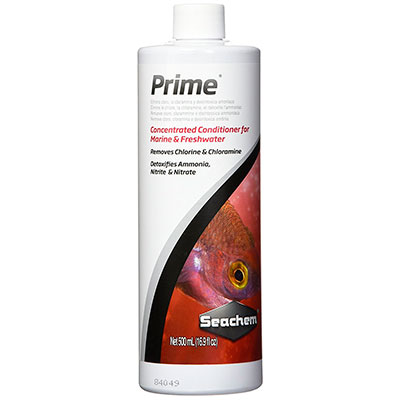
Or more specifically, Seachem Prime. I consider it to be the best aquarium water conditioner available.
Become to know this product. During a fish-in cycle, it'southward going to be your all-time friend.
Seachem Prime serves two purposes. The first is making your tap water safe…
You see, tap h2o contains chloramine and chlorine, two chemicals. Not only are these chemicals toxic to fish, but they also impale that beneficial bacteria. And without that, your tank won't cycle.
Fear not! A dose of Seachem Prime to your tap h2o before calculation it to your aquarium volition dechlorinate your water, making information technology safe for the benign bacteria and the fish when you lot finally add them.
Seachem Prime number likewise has the added benefit of neutralizing ammonia, nitrites and nitrates in your aquarium for 24 to 48 hours, making them harmless to your fish.
With these ii products on hand, you are now fix to brainstorm.
How do you perform a successful fish-in wheel?
Before I proceed, I want to make i affair clear:
The lives of your fish are at stake!
It's important that you carefully follow this guide. Read each step twice if you accept to. Brand certain you lot completely sympathise what you are doing before proceeding.
I cannot guarantee that your fish will survive the cycling process – some are more sensitive than others. Only past post-obit this guide, you give them the best possible run a risk.
When information technology comes to fish-in cycling, you lot have ii choices – cycling with Seachem Prime or with water changes.
A) Fish-in cycling with Seachem Prime
If you lot are a beginner or are simply looking for the easiest way to perform a fish-in cycle, then choose this option. This method uses daily dosing with Seachem Prime to return ammonia, nitrites and nitrates harmless to your fish.
The advantage is that you volition perform fewer water changes.
Jump to these instructions for a Seachem Prime fish-in cycle.
B) Fish-in cycling with water changes
If you desire to use fewer chemicals, yous tin can perform a fish-in cycle just with water changes. This method uses the diluting effects of fresh water to keep ammonia, nitrites and nitrates at a depression level.
Note: This method of fish-in cycling notwithstanding requires a bottle of Seachem Prime or other water conditioner to dechlorinate your tap h2o. Information technology's also nice to have on hand in an emergency – in example something goes incorrect.
Spring to these instructions for a water-modify focused fish-in cycle.
Performing a fish-in bicycle with Seachem Prime
Stride 1: Prepare your aquarium
It'southward time to fix your aquarium. And, that includes all the equipment – heaters, filters, air pumps… Become it in there! Don't forget to rinse it with fresh h2o first!
The beneficial leaner need a surface to cling to, namely your substrate and filter media. So by setting everything upwardly, you give your bacteria as many surfaces as possible to cling to.
Add together water to the tank, and don't forget to dechlorinate it with your water conditioner get-go.
Finally, you desire to go along all electric equipment, such as heaters, filters and bubblers, switched on throughout the entire cycling process. Not only will this proceed your fish every bit comfortable as possible, merely it will as well make your tank bicycle faster.
Want to cycle your tank as speedily as possible? Check out FishLab'south tips for speeding up the cycling process.
Step 2: Adding your fish
Before you add your fish, you want to acclimatize them first. This volition give them the best chance of survival.
You lot desire to feed your fish throughout the cycling process… Yous don't want them to starve!
When feeding your fish, however, it's of import that you lot don't feed them besides much. The more you feed them, the more than they are going to poop. And the more than they poop, the faster your ammonia levels are going to ascension.
Also, remove any uneaten nutrient from the tank, a adept aquarium net will make this easy. Whatever uneaten nutrient left behind will break down into ammonia, causing the levels to rise.
If a fish dies during the cycle, remove it from the aquarium ASAP. Its decaying body will also requite off ammonia. Don't panic if one of your fish dies. It doesn't necessarily hateful that all your fish volition – this one might have been actress sensitive.
Stride iii: Test, test, test, and examination once again
Now, use your ammonia examination kit every 24 hours.
What you are looking for is any sign of ammonia. Trust me. Information technology won't be long before it appears.
Once your test kit returns positive for ammonia, information technology'due south fourth dimension to move to the next step.
Stride four: Dealing with ammonia
Once y'all detect ammonia, information technology's time to start dosing with Seachem Prime. Follow the instructions on the bottle to determine what a single dose would be for your tank – the larger the aquarium, the more than Prime number you will need.
Fortunately, a little goes a long way, and many of you will find that a unmarried canteen of Prime will get yous through an entire cycle.
For this method, Seachem Prime number is the about important ingredient. You run across, a dose of Prime will bind ammonia, nitrite and nitrate for 24 to 48 hours, making them harmless to your fish.
Movie Seachem Prime number locking up ammonia, nitrite and nitrate in a jail cell for up to 48 hours. While in the cell, these nasties cannot damage your fish. However, one time their fourth dimension is upwards, and they are released, they will again attack your fish.
It is for this reason that you need to dose regularly with Seachem Prime, to continue these nasties locked up.
A unmarried dose of Prime number will care for upward to i office per 1000000 (ppm) of ammonia. Prime can be dosed up to 5 times safely. So, two ppm of ammonia can be treated with two doses of Prime, iii ppm tin be treated with three doses, and then on.
Anything less than 1 ppm should be treated with a single dose. Betwixt i ppm and ii ppm, 2 doses. You become the idea. Oh, and it goes without proverb that information technology's better to overdose than underdose.
One time your test kit reads two ppm of ammonia, you should perform a 50% water modify. This should cutting your ammonia levels roughly in half.
Repeat this process until you detect that your ammonia levels are not ascent as quickly as before. Typically, this volition accept a week or two. When this happens, you are set to move to the next step.
Bookmark this page so that y'all tin hands observe it when you are ready for the next step!
Footstep 5: Nitrites start to appear
Next, you need to test for nitrites. If none are present, go on repeating the previous step and testing for nitrites daily until y'all get a positive issue.
At present that nitrite has entered the equation, you need to make certain you are dosing with plenty Prime number to protect your fish from both ammonia and nitrites.
Fortunately, working out your new dosage is pretty simple – just add your nitrite and ammonia readings together.
Let'southward say your exam returns the following…
| Ammonia | 0.25 ppm |
| Nitrite | 1.v ppm |
Adding the 2 together will requite you a total of ane.75 ppm. A double dose of Prime number will accept care of it.
This fourth dimension, if your combined ppm of ammonia and nitrite reaches iv, perform a fifty% water change.
Keep repeating this. You will eventually notice that your ammonia drops to zero. This is a good matter – bacteria are eating the ammonia every bit quickly as information technology is being produced, resulting in a zilch reading.
Keep daily dosing and testing for ammonia and nitrites. Once your nitrite levels stop rising as quickly, you are gear up for the next step.
Step 6: Nitrates announced
Now, you desire to exam for nitrates. If none are present, keep repeating the previous step and testing for nitrates daily until you get a positive event.
Once nitrates are present, yous are nearing the end (woohoo!). Continue testing for ammonia, nitrites and nitrates. Your ammonia levels should still be goose egg, and your nitrite levels should be declining.
Go on dosing with Prime until both your nitrite and ammonia levels are zero. At this stage, the benign bacteria are eating them as quickly equally they are being produced.
Congratulations! You have successfully completed a fish-in cycle.
Performing fish-in cycling with water changes
Step one: Ready your aquarium
It'due south time to ready upward your aquarium. And, that includes all the equipment – heaters, filters, air pumps… Go information technology in there! Don't forget to rinse it with fresh h2o first!
The beneficial bacteria need a surface to cling to, namely your substrate and filter media. And so by setting everything up, you lot give your leaner every bit many surfaces every bit possible to cling to.
Add water to the tank, and don't forget to dechlorinate it with your water conditioner first.
Finally, you lot desire to keep all electrical equipment, such as heaters, filters and bubblers, switched on throughout the unabridged cycling process. Not merely will this keep your fish equally comfortable as possible, only it will also make your tank wheel faster.
Want to cycle your tank as quickly as possible? Cheque out FishLab'southward tips for speeding up the cycling process.
Step two: Add together your fish
Before yous add your fish, y'all desire to acclimate them start. This will give them the best hazard of survival.
Yous desire to feed your fish throughout the cycling process… Y'all don't desire them to starve!
When feeding your fish, however, it's of import that you don't feed them too much. The more than you feed them, the more they are going to poop. And the more they poop, the faster your ammonia levels are going to rise.
Also, remove any uneaten food from the tank. This, besides, will break down into ammonia if left behind.
If a fish dies during the cycle, remove information technology from the aquarium ASAP. Its decaying body volition also requite off ammonia. Don't panic if one of your fish dies. It doesn't necessarily mean that all your fish volition – this one might have just been extra sensitive.
Step 3: Test, test, test, and examination again
Now, apply your ammonia test kit every 24 hours.
What yous are looking for is any sign of ammonia. Trust me. It won't be long before it appears.
One time y'all notice ammonia building up, information technology'due south time to exam your aquarium twice a day. And, you demand to make it a routine. If you exit the house during the day, morning and night are fine.
Step 4: Water change afterwards h2o alter
You want to keep the ammonia levels depression, at a tolerable level for your fish. So, 0.25 parts per million (ppm) or less is your goal.
The moment y'all discover the ammonia levels reach 0.v ppm, y'all desire to perform a 50% h2o modify. That is, remove 50% of the water from your aquarium and supplant it with fresh water. Don't forget to add the dechlorinator!
What this does is remove some of the ammonia from your aquarium, diluting it and lowering the levels.
Now, just how often you lot need to practice this entirely depends on the size of your tank and how many fish you are cycling with.
Some of y'all might only demand to do a water change twice a week, simply others might need to do it twice a solar day. That's fine. Allow the examination kit decide how often to practice a water change.
Go along this up for at least a week before moving to the adjacent step.
Bookmark this page so that you can hands find it when yous are ready for the side by side stride!
Step 5: The first beneficial leaner appears
Afterwards a week, you will discover that your ammonia levels are non rising as quickly as they were before. This is a expert sign that the get-go beneficial bacteria has entered your tank and is eating the ammonia, helping to keep the levels downward.
To make sure that this is the case, you now want to test for nitrites. And so, use your nitrite test kit. If it comes back positive for nitrites, congratulations!. Yous are in the first stage of the nitrogen cycle, but your work is far from finished…
Don't worry if y'all don't meet nitrites yet. But repeat Step four and go on testing for nitrites until you do. Be patient. Call up… Fish-in cycling takes a lot longer than fishless cycling.
Stride 6: More water changes
If anything, nitrites are more toxic than ammonia. You want to go on nitrites as close to cypher as possible. And to exercise that, you lot must proceed performing water changes.
Continue monitoring your ammonia and nitrites on a daily basis, and perform water changes when your nitrite levels rising.
Keep doing this for at least some other week before moving to the next footstep.
Step seven: The 2nd beneficial bacteria appear
After another calendar week, the nitrite levels should not exist ascent as rapidly as they were before. This is a good sign that the 2nd benign leaner is beginning to grow in your aquarium.
To brand sure, catch your nitrate exam kit. If it returns positive for nitrates, celebrate! Y'all are on the home stretch.
Once more, it tin take longer than a week for nitrates to appear. Just keep repeating Pace 5 until your nitrate test indicates that they are nowadays in your tank. Patience, patience, patience. Did I mention patience?
Step 8: Continue testing and performing water changes
All that's left to exercise is to keep testing, monitoring your ammonia, nitrite and nitrate levels.
If your nitrate levels creep over twoscore ppm, information technology's time for a h2o alter. Although if you are performing h2o changes to keep your nitrites depression, I'd exist surprised if your nitrate levels ever accomplish this.
Proceed this process until both the ammonia and nitrite levels read zero on the same mean solar day. Remember, the entire cycling procedure can take months. So again, be patient.
What's side by side? Life after cycling
Woohoo!
Y'all did it!
The beneficial bacteria in your tank are in loftier enough numbers that they can eat ammonia and nitrites as quickly as they are produced.
It might have taken a long time, but trust me, information technology was worth it!
Your tank is at present safe for your fish. Any fish that survived deserve a medal of award because they made the tank safety for any new fish you want to add.
On that annotation…
If y'all desire to add more fish to your tank (bold your tank is large enough), await a week before adding a maximum of three. This gives the bacteria a gamble to adapt to the increase in waste product and abound in numbers to deal with information technology.
All the same want to add together more fish? Look some other week and repeat.
And remember, from this indicate on, nitrates will consistently build up in your aquarium. This is a major reason why we perform regular water changes – to keep the nitrate levels low.
Conclusion
Phew, yous did information technology. I knew y'all could!
By cycling your aquarium, you lot requite your fish the all-time possible chance to live a happy and healthy life.
In one case the nitrogen cycle has started, it consistently runs in the background.
But you are not home free just yet…
You still need to regularly monitor your ammonia and nitrite levels to ensure that nothing goes wrong. I recommend that you include testing your tank every bit part of your regular h2o alter routine.
Practise you cycle your aquarium with fish inside? Let me know in the comments below!
Source: https://fishlab.com/fish-in-cycle/
0 Response to "Alexa Im Having Trouble Understanding Right Now Please Try Again Later"
Post a Comment